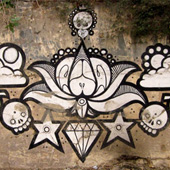What is an outdoor graffiti mural? They can be large vibrant beautiful paintings made to liven up the city, get across a message to the widest audience around. Such artworks follow little or no rules with an undercurrent of underground subcultures.
Why make them?
• To add a dash of colour to the otherwise grey urbanscapes.
• Using art to get across a message.
• As a form of resistance.
• To give people a chance to view and share something creative, beautiful, abstract or unexpected in a public space to be interpreted any way they want to.
... or just for the fun of it.
Where are these murals made?
You will often find them in busy, bustling streets, dull lifeless parking lots, in lanes and alleys, where you wouldn't expect to find them. It depends on why are you making it, by whom is it to be seen and what it is reflecting. They are also often done in sections of the city that need a makeover of some kind.
Who makes them?
Anyone with a passion for painting and expressing their thoughts. Artists who want to share their work through public spaces. People who are affected by the changing times, cities and lifestyles use it as a form of resistance and a creative expression of protest.
Graffiti Murals have their origins as acts of vandalism, messing up of public spaces and properties. This was an expression of defiance against the ‘authorities’ towards whom they felt resentment. They were often a form of marking territories for street gangs.
However, graffiti murals today have evolved into an art form where local people and artists come together to participate in reviving neighbourhoods, uplifting the forgotten parts of the city through biennales and street art shows. In many cities across the world, specific areas and sections of the cities are reserved for such artworks.

A graffiti on the Ghats of the Ganges by an Portuguese artist. With mixed cultures and a strong subculture of Hinduism, Varanasi makes a good canvas for Graffiti murals, which are sketched on the Ghats by artists from India and beyond.

